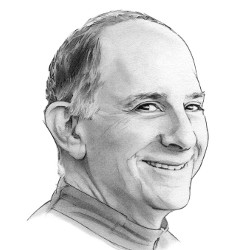
I became Editor-in-Chief of Communications of the ACM (CACM) to make the magazine again the forum where the computer science community shares ("communicates") its most important results. Whether you compute with bits or qubits, write software or proofs, develop algorithms or neural networks, teach or take classes, work in industry or academia, live in the U.S. or elsewhere, believe tech is the way forward or not, CACM should be the place to share your best work with our broad, diverse, and international community.
Early in my career, CACM played this role. Everyone in the field read the magazine, and the CS community shared its most important results there. To get a sense, look at the 1983 CACM 25th Anniversary issue (https://dl.acm.org/toc/cacm/1983/26/1), which reprinted articles from the magazine's early years. Many of you will recognize the seminal papers in programming languages (Algol 60, parsing, program semantics), operating systems (concurrency control, memory working set, parallel programming, Ethernet, Unix), databases (relational DBs and hashing), cryptography (RSA), and software engineering (Hoare axioms, stepwise refinement, modules).
As computing exploded in the 1980s and 1990s, the community expanded rapidly and lost the habit of communicating with colleagues from different fields. CACM slipped into torpor until Moshe Vardi's great efforts 15 years ago revived it.
But CACM has not returned to its roots. It publishes excellent and interesting articles, but many, if not most, significant new results still appear only in conference and journal papers that are read by a narrow community. Our field should not stop publishing in those venues, but it should also re-adopt its former habit of sharing its best results with the computing community. When authors do not communicate their significant results to the greater community, they forego an opportunity for broad impact, and we are all left poorer. If this resonates, and you want to tell the computing community about your work with bits, qubits, proofs, good algorithms, bad algorithms, neural networks, or the impact of our field, please share it with CACM.
As part of its evolution, I also want CACM to reach out to more of our community, particularly non-academic practitioners and people of diverse backgrounds and regions who have infrequently contributed to this magazine Many CACM readers—and most of the computing community—are not in academia, but CACM and ACM have long had a strong academic focus. This will not change, but the move to Web-first (as I will discuss) enables the magazine to expand its practitioner-focused content by publishing more diverse topics.
I will also continue my predecessor Andrew Chien's highly successful regional special sections, which enabled a greater part of the world to share their successes with the CS community. Increasingly, however, these articles and editors will be integrated into CACM itself so the website and magazine fully reflect the global computing community.
Finally, CACM will reach out to the computer science community that does not belong to ACM. The computing field has grown immensely in the past few years, while ACM has not, leaving most of our community outside the organization. CACM can help reverse this trend by providing a forum for the entire community to share its ideas, goals, and results. As a first step, all content on the new website will be open access (the current site is partially open).
Web-First CACM
I became editor-in-chief of CACM on January 1. In July, seven months later, you are reading my first column (still later if, like me, you are outside of the U.S.). Half-year publishing delays were unavoidable in the 17th century when scientific journals began. Some 300 years later, our field developed the Internet and Web and severed the connection between publishing and physical media. CACM nevertheless has remained a print magazine, with its delays and limited space, while ACM proceedings and journals live in cyberspace.
My immediate goal is to bring CACM into the 21st century by making it Web-first. ACM members will still receive CACM on paper. However, its editorial content will first appear on a new CACM website (under development). This site will allow CACM to make content available when written and edited, not at the end of a long publication process. It will also eliminate the need for page limits that preclude the publication of additional and extended articles. The Web also permits authors to use richer media such as video, executable code, and podcasts to better present their ideas. The best of the website will appear in the print magazine—months later.
Assistance Welcome
What can you do to help? CACM is always looking for high-quality articles and Viewpoint pieces that appeal to a broad audience. I am also looking for associate editors in many fields. And, if you have a suggestion or idea, please share it. My email address is eic@cacm.acm.org. I look forward to hearing from you.
James Larus, EDITOR-IN-CHIEF



Join the Discussion (0)
Become a Member or Sign In to Post a Comment